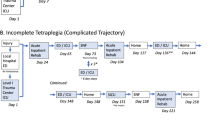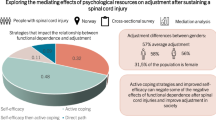Abstract
Study Design:
Qualitative study.
Objectives:
To develop the knowledge base regarding women's experiences of spinal cord injury (SCI) rehabilitation.
Setting:
United Kingdom.
Methods:
Qualitative interviews with 10 women from four regional SCI rehabilitation centres were transcribed verbatim and analysed according to grounded theory.
Results:
The central psychosocial problem identified for women during SCI rehabilitation was vulnerability. Vulnerability was amplified by lack of privacy within the rehabilitation centre, by negative staff interactions (associated with perceived lack of control and lack of respect) and by women's minority status in the rehabilitation setting, which at times left women feeling marginalized and inferior. Vulnerability was contained by: negotiating privacy and space; receiving support and encouragement from staff, other patients and family; and by adopting a positive attitude.
Conclusion:
The SCI rehabilitation environment and interactions within it have the potential to influence significantly, either positively or negatively, women's feelings and behaviours as they begin to negotiate a revised identity as a disabled person. There is a need for further research to be carried out in this area in order that women's needs and concerns can be better understood and clinical practice developed accordingly.
Similar content being viewed by others
Log in or create a free account to read this content
Gain free access to this article, as well as selected content from this journal and more on nature.com
or
References
Morris J (ed). Able Lives. The Women's Press: London, 1990.
Sipski ML, Alexander CJ . Spinal cord injury and female sexuality. Annu Rev Sex Res 1995; 6: 224–244.
Kreuter M, Sullivan M, Dalloff AG, Siosteen A . Partner relationships, functioning, mood and global quality of life in persons with spinal cord injury and traumatic brain injury. Spinal Cord 1998; 36: 252–261.
Annual Statistical Report for the Model Spinal Cord Injury Care Systems. University of Alabama at Birmingham: National Spinal Cord Injury Statistical Center, 2004.
Shackleford M, Farley T, Vines CL . A comparison of women and men with spinal cord injury. Spinal Cord 1998; 36: 337–339.
Cole J . Still lives. Narratives of Spinal Cord Injury. The MIT Press: London, 2004.
Nosek MA, Hughes RB . Psychosocial issues of women with physical disabilities: the continuing gender debate. Rehabil Couns Bull 2003; 46: 224–233.
Thomas L (ed). Link to life. Spinal Cord Injury. Boxtree: London, 1994.
Pentland W, Walker J, Minnes P, Tremblay M, Brouwer B, Gould M . Women with spinal cord injury and the impact of ageing. Spinal Cord 2002; 40: 374–387.
Harrison J, Glass CA, Owens RG, Soni BM . Factors associated with sexual functioning in spinal cord injury. Paraplegia 1995; 33: 687–692.
Krause KS, Broderick L . Outcomes after spinal cord injury: comparisons as a function of gender and race and ethnicity. Arch Phys Med Rehab 2004; 85: 355–362.
Forsythe E, Horsewell JE . Sexual rehabilitation of women with a spinal cord injury. Spinal Cord 2006; 44: 234–241.
Hammell KW . Spinal Cord Injury Rehabilitation. Chapman & Hall: London, 1995.
Charmaz K . Grounded Theory. In: J Smith (ed). Qualitative Psychology. Sage: London, 2003, pp 81–110.
Glaser BG, Straus AL . The Discovery of Grounded Theory: Strategies for Qualitative Research. Aldine Publishing: New York, 1967.
Chiovitti RF, Prian NP . Rigour and grounded theory research. J Adv Nurs 2003; 44: 427–435.
Department of Health. The Essence of Care: Patient-Focused Benchmarks for Clinical Governance. The Stationery Office: London, 2001.
Woogara J . Patients' rights to privacy and dignity in the NHS. Nurs Stand 2005; 19: 33–37.
Brennan J . Cancer in Context. Oxford University Press: New York, 2005.
Schain WS . Patients' rights in decision-making. Cancer 1980; 46: 1035–1041.
Mahon-Darby J, Ketchik-Renshaw B, Richmond TS, Gates EM . Powerlessness in cervical spinal cord injury patients. Dimens Crit Care Nurs 1988; 7: 346–355.
Seymour W . Remaking the Body. Routledge: London, 1998.
Foss C, Sundby J . The construction of the gendered patient: hospital staff's attitudes to female and male patients. Patient Educ Couns 2003; 49: 45–52.
Vlassof C, Moreno CG . Placing gender at the centre of health programming: challenges and limitations. Soc Sci Med 2002; 54: 1713–1723.
Duff J, Evans MJ, Kennedy P . Goal planning: a retrospective audit of rehabilitation process and outcome. Clin Rehabil 2004; 18: 275–286.
Tucker SJ . The psychology of spinal cord injury: patient–staff interaction. Rehab Lit 1980; 41: 114–121.
Pennebaker J . Emotion, disclosure, and health: an overview.In: J Pennebaker (ed). Emotion, Disclosure, and Health. American Psychological Association: Washington 1995, pp 3–10.
Acknowledgements
We thank Kate Gleeson, Research Director, at the Bristol Doctorate in Clinical Psychology for her help, support and advice.
Author information
Authors and Affiliations
Rights and permissions
About this article
Cite this article
Samuel, V., Moses, J., North, N. et al. Spinal cord injury rehabilitation: the experience of women. Spinal Cord 45, 758–764 (2007). https://doi.org/10.1038/sj.sc.3102111
Published:
Issue date:
DOI: https://doi.org/10.1038/sj.sc.3102111
Keywords
This article is cited by
-
Strengths, gaps, and future directions on the landscape of ethics-related research for spinal cord injury
Spinal Cord (2023)
-
The meaning of self-care in persons with cervical spinal cord injury in Japan: a qualitative study
BMC Neurology (2013)
-
Barriers to sexual activity: counselling spinal cord injured women in Malaysia
Spinal Cord (2011)
-
Functioning and disability in spinal cord injury from the consumer perspective: an international qualitative study using focus groups and the ICF
Spinal Cord (2010)



